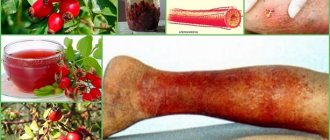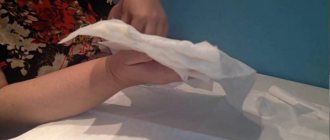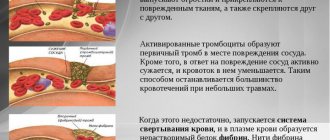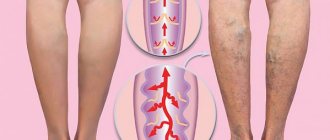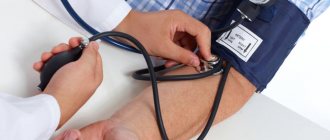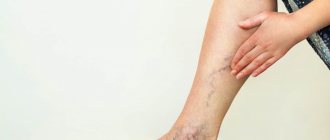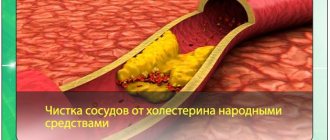Thrombophlebitis
– a disease characterized by inflammation of the vein wall and the formation of a blood clot. A thrombus is a blood clot that blocks the lumen of a vein and impedes the outflow of blood. The process can develop both from inflammation to the formation of a blood clot, and from a blood clot to inflammation. In the first case, inflammation from the tissues surrounding the vein can spread to the vein wall and a blood clot forms in the place where the wall tissue is changed. In the second case, the blood clot causes blood stagnation, which contributes to the development of inflammation.
If inflammation of the vein walls is observed without the formation of blood clots, they speak of phlebitis
.
Thrombophlebitis more often affects the vessels of the legs, while with superficial vein thrombosis, inflammation of the walls is observed more often than with deep vein thrombosis, therefore, thrombophlebitis of the superficial veins
from
deep vein thrombosis of the lower extremities
, which is a more dangerous disease.
Treatment of thrombophlebitis of the lower extremities with folk remedies
Thrombophlebitis of the legs can be effectively treated with folk remedies only in the initial stage of thrombus formation. Later, when the blood clot has formed and the inflammatory process is already developing, it is no longer possible to do without the help of a doctor. But at all stages of treatment, traditional medicine recipes can promote recovery.
Treatment of thrombophlebitis of the lower extremities using decoctions according to folk recipes
You can begin treatment of thrombophlebitis of the lower extremities with folk remedies only after consulting a doctor. The disease is serious, often leading to disability and even death of the patient, so you should not self-medicate. As an addition to therapeutic treatment, you can take infusions and decoctions of medicinal herbs.
- Kirkazon ordinary. This herb has a venotonic effect, take 1 glass a day as a decoction.
- Horse chestnut strengthens the walls of blood vessels and helps dissolve blood clots. The fruits and flowers of this plant are useful. The raw materials are infused with vodka or ethyl alcohol for two weeks. The resulting infusion begins to be taken as soon as the first symptoms appear, and thrombophlebitis of the lower extremities disappears much faster.
- Fresh cucumber juice helps relieve leg pain. Take two glasses on an empty stomach.
- Hazel. Take a decoction of leaves or bark orally 4 times a day before meals, half a glass.
- When is acute thrombophlebitis of the lower extremities diagnosed? Treatment with traditional methods includes the use of garlic. To prepare the infusion, I grind 200 g of raw material and pour it with warm water. After six hours, filter the product and take half a glass per day. If necessary, you can dilute the broth with water.
- Calamus is infused with apple wine and taken half an hour before meals, a tablespoon three times a day.
- Verbena officinalis helps soften the blood clot and increase the lumen of the vessel. Take a tablespoon of the decoction every hour.
- Shilajit, diluted in boiled water (0.15 g per tablespoon), relieves swelling and pain. Take no later than two hours before meals.
- Collection: 10 g lemon balm + 10 g yarrow + 10 g rose hips + 15 g buckthorn. A decoction is prepared from the resulting mixture and taken a glass twice a day.
- Stinging nettle. Drinking a decoction of this plant and following a diet helps cure even deep thrombophlebitis.
Some plants have an effect not only on diseased blood vessels, but also on other organ systems. Therefore, even folk remedies have a number of contraindications. If herbs are used incorrectly and there is no adequate therapeutic treatment, deep thrombophlebitis of the lower extremities develops; surgery in this case will be the only means of saving the patient’s life.
Compresses for the treatment of thrombophlebitis of the legs
Local effects on the affected areas of the veins can relieve pain, relieve swelling, and reduce inflammation. For compresses you can use the following recipes:
- Millet + onions + old lard + 200-250 g of laundry soap. Everything is crushed and diluted with water. Insist for 24 hours. The resulting ointment is applied at night to the site of the thrombus in courses of 10 days with a 10-day break. Take at least three courses.
- Fresh leaves of cabbage, lilac, and golden mustache effectively relieve inflammation. The plants are ground until the juice appears and applied to the feet at night.
- Alcohol tinctures of Kalanchoe, white acacia or chamomile are used for rubbing.
- Silver wormwood is crushed and mixed with curdled milk 1:1. Compresses are applied for 4 days, then take a break and repeat the treatment.
- Fresh tomatoes are cut into slices and applied to the diseased areas of the veins.
- St. John's wort and vegetable oil are mixed 1:10 and heated in a water bath for three hours. The mixture is cooled at room temperature and then filtered. A paste of golden mustache leaves is added to the resulting product. The ointment is effective in the treatment of skin lesions and trophic ulcers.
- Calendula oil infusion has an anti-inflammatory and anti-edematous effect.
There are many recipes. For those who seek to eliminate thrombophlebitis of the lower extremities once and for all, treatment with folk remedies will be a good help. Decoctions of medicinal herbs, rubbing and compresses can be used to treat acute conditions, restore blood flow after surgery and prevent relapses. The main thing is not to forget to coordinate your actions with your doctor.
How to use Levomekol for burns
Due to the unique composition of leniment, it has pronounced antimicrobial and antibacterial properties. Increases local immunity, which is especially important for burns. In addition, it suppresses the effect of viruses, stimulates the restoration of tissue cells, relieves inflammation and prevents the necrotic process.
To treat burns, the damaged area is washed with an antiseptic solution and covered with a napkin containing Levomikol. The dressing is changed up to 5 times a day.
The drug is used for varying degrees of burns. The duration of the course of treatment is determined by the doctor.
Thrombophlebitis
Thrombophlebitis is the formation of venous blood clots due to inflammatory processes on the inner walls of the veins. There are acute, subacute and chronic thrombophlebitis. According to the nature of the course, the inflammatory thrombus-forming process can be either purulent or non-purulent, and according to its localization, it can affect deep or superficial blood channels.
Despite the fact that the disease can affect absolutely any human vein, in most cases it develops in the lower extremities, as a result of which doctors make that very terrible diagnosis - thrombophlebitis of the lower extremities or deep thrombophlebitis of the lower extremities (in about 10% of cases).
Thrombophlebitis of the extremities occurs for a number of reasons. First of all, these are injuries and chronic diseases of the cardiovascular system. Often the cause of the formation of blood clots in the veins is the course of common infectious diseases, as well as complications after abortions and other surgical interventions. Other causes include varicose veins, blood diseases, the postpartum period and local purulent processes.
loading.
News
Prevention of blood clots in blood vessels
Platelets are one of the elements of our blood. Their natural purpose is to form a kind of “plug” when the integrity of the vessel is violated. If a wound appears, the platelets stick together, forming a small blood clot, and close the rupture site. This is how the mechanism for stopping bleeding is carried out. Sometimes this very mechanism fails, and thrombosis begins in the body.
Thrombosis is a chronic lifelong formation of platelet accumulations in blood vessels, parts of the heart, brain, and other organs.
The reasons for the formation of blood clots in blood vessels can be very diverse: heredity; improper diet; blood thickening; smoking and alcohol; sedentary lifestyle; problems with blood clotting; frequent stress, tension; phlebeurysm; atherosclerosis of arteries; oncological diseases and chemotherapy; postoperative rehabilitation period; congenital or acquired pathologies; infectious diseases; STI; taking hormonal and contraceptive medications;
pregnancy.
How to prevent blood clots? Basic tips for prevention are as follows:
-Normalize physical activity. Do exercises every day to tone blood vessels and restore blood circulation. If your job is sedentary, then try to do exercises or exercise in the morning and evening, do gymnastics or go to the gym.
-Spend time in the fresh air more often. This enriches the blood with oxygen, which has a beneficial effect on the functioning of the entire body.
-Complete cessation of bad habits. Alcohol and tobacco destroy the walls of blood vessels, making them thin and fragile.
-Do not wear tight, constricting clothing. In the compressed area, capillaries may be injured and platelets may accumulate.
-Change your usual diet, follow a special diet. Products must be specially selected, taking into account the individual characteristics of your body and your specific case of blood clot formation.
-Taking medications to thin the blood and improve the condition of blood vessels, strengthening them. As a rule, a complex of vitamins and anticoagulants are prescribed.
Drug prevention.
If there are already blood clots in the body, they need to be dealt with using medications. Substances that thin the blood are called anticoagulants. The specific drug and regimen for taking it will be prescribed to you by your attending physician, whom you will need to see regularly for consultation. If the thrombosis is caused by the use of medications, then the first step to recovery is not to take them anymore.
Drug prevention is aimed exclusively at improving the condition of the circulatory system: vitamins strengthen the walls of blood vessels from the inside and outside, anticoagulants thin the blood.
Remember that untimely treatment can lead to a heart attack or stroke. If a blood clot breaks off and travels through the body, it can stop and block a vessel leading to one of the vital organs. Pulmonary embolism is often fatal. The consequences are terrible, so when the first signs appear, do not hesitate to contact a doctor, he will tell you how to avoid complications.
Folk remedies for prevention
In order not to resort to medications, there are traditional methods to get rid of thrombosis. The main method of treatment is herbal teas and tinctures. There are many readily available plants that are natural anticoagulants. Drinking these drinks has a positive effect on eliminating clots.
For example, blueberries, viburnum, currants, sea buckthorn, raspberries - unravel blood clots.
Birch buds, linden leaves and flowers, hawthorn, dill, rose hips and others will help strengthen arteries, veins, and capillaries.
Diet to avoid blood clots
All platelets are composed of the protein fibrinogen. It is produced by the liver and then converted into fibrin. It is fibrin that plays the main role in blood clotting.
With the help of a properly structured diet, you can help your body thin and thicken the blood. For example, garlic, salmon, ginger are natural anticoagulants. There are products that regulate the level of fibrinogen in the blood: they lower or increase and, accordingly, slow down or accelerate the dissolution of platelet accumulations. Some affect the thickness and viscosity of the blood. That’s why the most important thing is to stick to your diet and watch what goes into your body.
The list of recommended products is extensive:
onion - oddly enough, this affordable product contains substances that prevent platelets from sticking together and help liquefy formed clots;
garlic - contains a powerful anticoagulant achoene, which is used to make medicines;
fish - Statistics show that people who eat at least a piece of fish every day are 2 times less likely to have heart attacks than those who do not eat fish at all. It is fatty fish or fish oil in its pure form that have the strongest antithrombotic effect. Fish oil acts on platelets so that they simply lose their ability to stick together;
olive oil - reduces the stickiness of colorless blood cells and prevents them from sticking together;
vegetables are the main enemies of blood clots. Fresh vegetables and fruits, high in vitamin C and fiber, help break down platelet clumps and prevent them from sticking back together.
You will have to give up many of your favorite foods, but the effect is worth it: sugar; all flour products;
Recommendations from experts
Doctors recommend that at the first sign of thrombosis, contact a specialist for qualified help. Since thrombosis is not an independent disease, but only a sign of another, more serious disease, you need to undergo additional examination, examinations and tests. Doctors certainly know how to identify thrombosis and prescribe the right course of treatment.
Take care of yourself and your health. Don’t self-medicate; it’s easy to make the situation worse, but getting rid of the consequences will take a long time and be difficult.
Exercise and proper nutrition are the key to a healthy body!
Prepared by:
Pikulskaya N.V.
Treatment
There are several ways to combat thrombophlebitis. The first is conservative treatment, which involves taking medications, intense physical activity and applying compresses.
The second method is surgical intervention, indicated for ascending forms of inflammation of the great and small saphenous veins with the threat of thrombosis spreading to the deep veins. Depending on the characteristics of thrombophlebitis, its treatment in surgery may involve either ligation of the saphenous veins or removal of varicose eyelids.
Compression treatment
This method is used most often in the chronic course of the disease, after inflammation has subsided, and for prevention. In addition, it is effective only for thrombophlebitis of the superficial veins . It is not prescribed for deep vein pathology.
Medical knitwear is used: tights, stockings, knee socks of different lengths and with compression class 2 or 3. The use of special elastic bandages is effective. Bandaging is carried out at the beginning of the day, and the bandages are removed at night. This helps maintain limb tissue in good shape. Knitwear and bandages prevent the expansion of veins and the separation of a blood clot. After a few days it may completely resolve.
Also, in chronic and subacute forms, warm compresses are prescribed. They improve blood circulation and elasticity of tissues and blood vessels.
Treatment of thrombophlebitis of the lower extremities with folk remedies
Thrombophlebitis is phlebitis (inflammation) of a vein caused by a thrombus (blood clot). When talking about this disease, we most often mean phlebitis of the venous walls of the lower extremities, caused by a blood clot formed in the lumen of the vein. Thrombophlebitis is diagnosed visually; an external examination of the affected area does not require further examination, but sometimes it may be necessary to monitor the pulse, temperature, pressure, study the condition of the skin and blood circulation. Treatment of thrombophlebitis of the lower extremities with folk remedies at various stages of the disease is often considered as an alternative method.
What is Levomekol used for?
The drug is prescribed for the treatment of the following conditions:
- Skin infections due to pathogenic pathogens.
- Calluses.
- Pimples, boils, blackheads.
- Burn lesions, especially 2nd and 3rd degrees.
- Inflammation of the ear and sinuses with purulent discharge.
- Hemorrhoids.
- Bedsores.
- Postoperative wound care.
- Death of individual sections of tissue.
- Eczema.
What folk remedies are most effective for treating thrombophlebitis?
Most of the described folk methods for treating thrombosis are quite simple; the recipes contain components that are accessible to everyone. Here are some of the most popular recipes.
Honey compress: spread honey on a linen cloth and apply to the affected areas: in the first 3 days for 2-4 hours a day, then you can leave it overnight. You should wrap your leg with something warm over honey cloth secured with a bandage.
Cabbage compress is very effective for thrombosis and hematomas. It is done like this: lightly beat the cabbage leaf and score it with a sharp knife, coat one side of the leaf with honey or vegetable oil, apply it to the affected area, cover it with a natural cloth and secure it with a bandage. This compress should be kept for as long as possible, if possible, then 24 hours. The effect will be noticeable after the first use, but treatment must be continued for a month.
Treatment with bitter and silver wormwood, calamus rhizome, male fern herb, Kalanchoe, ripe tomatoes, apple cider vinegar and even lard is also effective against thrombophlebitis.
The effectiveness of treatment is greatly increased by light exercise for the legs, massage, and walking. It is necessary to avoid prolonged sitting in one position, especially cross-legged.
Thrombophlebitis of deep and superficial veins: acute and chronic. Diagnosis, treatment, prevention
All materials on the site are published under the editorship of professional doctors,
but are not a prescription for treatment. Contact the specialists!
Among vascular diseases, there is one that doctors consider the most insidious, with consequences that are difficult to predict. This is thrombophlebitis of the lower extremities. This is the name of the inflammatory process of the venous walls, which leads to the formation of a blood clot in the venous lumen. A disease that develops in the vessels of the legs is the most common form. But sometimes (albeit much less frequently) other forms occur - thrombophlebitis of the upper extremities, as well as the cervical and thoracic regions.
Each person has a network of veins located on the surface (under the skin) and hidden in deeper layers. Depending on this, two types of the disease are distinguished:
Thrombophlebitis of deep veins
The signs of this type of pathology largely depend on the location of the affected vessel. Among the acute forms, thrombophlebitis of the deep veins of the leg stands out in its frequency. It is characterized by the appearance of sudden pain, bursting the muscles of the lower leg. The pain may subside a little if you put your leg in a horizontal position. However, an almost painless manifestation is possible in the presence of other symptoms of thrombophlebitis: swelling, bluish color of the skin and its tension. When pressing on the skin, a dimple remains, which gradually smoothes out.
On the other hand, the disease can pass without any obvious signs at all. With thrombophlebitis of the femoral vein and deep veins of the pelvis, the presence of a blood clot may be indicated by slight swelling on the inner surface of the thigh and mild pain in the groin area. Thrombophlebitis of the iliofemoral segment of the main vein also has subtle signs. It manifests itself as mild pain in the lower back, near the sacrum, and in the lower abdomen. And in some cases, the only symptom may be thromboembolism - when the blood clot has already broken off.
Thrombophlebitis of the deep veins of the lower extremities also manifests itself as a general malaise. Body temperature can rise to 40o. And if the common femoral vein is affected, the patient may have a fever and there are signs of intoxication of the body.
The acute form in almost all cases is characterized by the appearance of acute pain at the site of blood flow disturbance. The swelling may be loose at first and then gradually harden. In the affected area, veins clearly appear on the surface of the skin, and the temperature rises significantly. When making a diagnosis, the doctor places a sphygmomanometer cuff near the affected area and monitors the increase in pressure that causes acute pain. In acute cases, a pressure of 45-60 mmHg is sufficient.
The chronic form by a long course, and the symptoms of thrombophlebitis can appear from time to time for 2-3 years without significant deterioration. The thrombus may be partially destroyed, the patency of the vessel temporarily improves, and the vein wall is overgrown with connective tissue. But since the outflow of blood from the lower extremities is impaired, the symptoms return:
- swelling becomes stable;
- a feeling of fullness and heaviness in the leg haunts when walking;
- severe muscle cramps occur at night;
- dense formations appear under the skin;
- the skin itself acquires ring-shaped pigmentation.
Since such symptoms of thrombophlebitis of the lower extremities are extremely likely to cause dermatitis, eczema, and trophic ulcers, it is necessary to start treatment as early as possible.
Treatment
Treatment for the acute form of the disease is selected based on the condition of the blood vessels, the nature of the disease, and the location of the blood clot. Typically, conservative therapy is used for this, which includes local and general treatment. Patients diagnosed with acute thrombophlebitis of the forearm and lower leg can be treated on an outpatient basis. For all other types, patients are sent to the hospital. They are prescribed bed rest, the sore leg is in an elevated state.
After the acute inflammatory process has been relieved, to increase the efficiency of blood clot resorption, physiotherapeutic treatment with a Sollux lamp, diametric currents, and UHF is recommended. Good results are obtained by iontophoresis with heparin, proteolytic enzymes (chymotrypsin, trypsin, etc.), as well as with potassium iodide. Elastic compression should be continued for another two months after completion of the main treatment, while taking phlebodynamic drugs.
In the treatment of ascending thrombophlebitis, laser obliteration is also used, the essence of which is to heat the vein wall just above the thrombus. This allows you to remove pathological venous nodes from the main vessels, stopping the growth of a blood clot with an inflammatory process. An alternative technique for conducting a laser beam directed opposite to the movement of blood flow helps eliminate the likelihood of pushing a blood clot into the vessels. It is unique at this moment in time.
In case of ascending thrombophlebitis, an effective method that does not allow a blood clot to develop and penetrate into deep vessels is an operation associated with ligation of the place where the superficial vein passes into the deep one. It's called a crossectomy. The manipulation is performed using local anesthesia on an outpatient basis.
Chronic thrombophlebitis
Chronic thrombophlebitis, unlike the acute form, does not have pronounced signs and symptoms. In this form of the disease, pain is periodic in nature, mainly bothering after putting stress on the legs (long walking, etc.). At rest they are practically absent. Swelling is also minor. Therefore, a person is in no hurry to seek medical help.
In the treatment of the chronic form, an ointment for thrombophlebitis is used, constant elastic compression using special bandages or stockings, physical therapy, physiotherapeutic procedures and treatment at balneological resorts and mud baths are recommended.
Thrombophlebitis during pregnancy
Pregnancy is the period during which a woman is most often exposed to diseases such as varicose veins of the lower extremities and thrombophlebitis. This is due to an increase in their intrauterine pressure and physiological changes in blood composition. Thrombophlebitis poses the greatest danger in the first days of the postpartum period. Since most complications in the form of thromboembolism occur after childbirth. Childbirth is a huge overload on the vascular system.
As soon as these symptoms occur, you must immediately consult a phlebologist. He will conduct a duplex color scan to examine the state of the circulatory system and give recommendations on how to prevent the development of a more severe form of the disease and avoid complex treatment.
Thrombophlebitis of the superficial veins during pregnancy is often accompanied by severe pain. It must be remembered that taking medications is not recommended during this period. Venocentesis will help quickly relieve the patient of discomfort and prevent the blood clot from penetrating into the veins located in the deeper layers. This is a puncture of the affected node to remove the blood clot. This method is safe for the fetus, since the manipulation is performed under local tumescent anesthesia (an anesthetic drug is injected under the skin, forming a protective cushion around the operated vessel).
General recommendations
People who are at risk for thrombophlebitis need to be very attentive to the condition of their hands and feet. Follow the recommendations given by the phlebologist. You should lead an active lifestyle. Try to walk more, master special exercises that prevent the development of the disease. It's good to go swimming and ride a bike. At home, you can maintain the tone of blood vessels with vitamin teas, drink cranberry juice and St. John's wort tincture more often.
At the same time, avoid static tension, which occurs when a person sits or stands for a long time (for example, working at a machine). Steam baths and dehydration are contraindicated for thrombophlebitis. Shoes should be as comfortable as possible, with optimal heel height and orthopedic insoles. It is recommended to rest while lying down, slightly raising your legs and placing a small pillow under them. Compression garments should also be worn while lying down, with your legs raised up.
